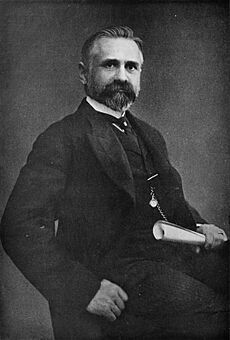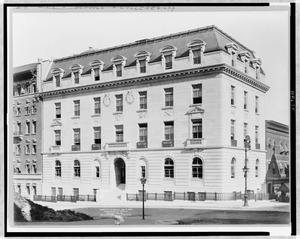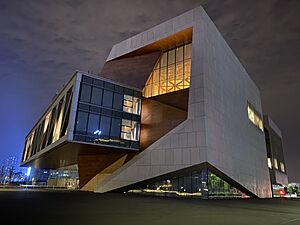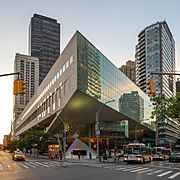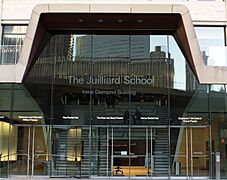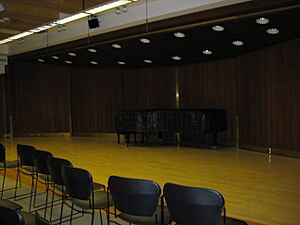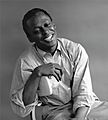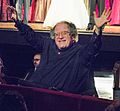Juilliard School facts for kids
 |
|
|
Former names
|
|
|---|---|
| Type | Private conservatory |
| Established | 1905 |
| Founder | Frank Damrosch |
| Accreditation | MSCHE |
| Endowment | $1.38 billion (2021) |
| President | Damian Woetzel |
|
Academic staff
|
138 FT/ 314 PT (2023) |
| Students | 1,028 (plus ~290 pre-college) |
| Undergraduates | 619 (2023) |
| Postgraduates | 409 (2023) |
| Location |
,
,
United States
40°46′26″N 73°59′00″W / 40.77389°N 73.98333°W |
| Campus | Small Urban |
| Colors | red and blue |
| Mascot | Penguin |
 |
|
The Juilliard School is a private performing arts school in New York City. It's famous for training talented students in music, dance, and drama. The school was started in 1905 by Frank Damrosch as the Institute of Musical Art. Later, it added dance and drama programs. The school was named after a generous supporter, Augustus D. Juilliard.
Juilliard has three main parts: dance, drama, and music. The music program is the oldest and largest. Students can earn college degrees or special diplomas. There are also programs for younger students who are still in high school or even younger. Juilliard has one campus at the Lincoln Center for the Performing Arts. It has many practice rooms, performance halls, a library, and a place for students to live. It's one of the hardest schools to get into in the United States. About 950 students attend Juilliard, and they perform in many groups throughout the year.
Many famous people have studied at Juilliard. Its alumni have won over 100 Grammy Awards, 60 Tony Awards, 45 Emmy Awards, and 20 Academy Awards. Musicians from Juilliard often become top performers or lead orchestras. Many alumni and teachers have also won major awards like the Pulitzer Prize.
Contents
History of Juilliard
How Juilliard Started: 1905–1946
In 1905, Frank Damrosch started the Institute of Musical Art (IMA). He believed the United States needed a top music school so students wouldn't have to go to Europe to study. A kind banker named James Loeb gave a lot of money to help start the school.
Damrosch and Loeb wanted to create a music school with very high standards. They wanted to make sure that good teaching was available to everyone, no matter how much money they had.
The Institute of Musical Art opened on October 11, 1905. Most of the teachers were from Europe, but only American students could attend. Even though orchestras were mostly men back then, most of the students were women. The school started with 467 students, and that number quickly grew. Five years later, the institute moved to a new building on Claremont Avenue in Manhattan.
In 1919, a rich businessman named Augustus D. Juilliard left a lot of money in his will to help music. This money created the Juilliard Musical Foundation (JMF) in 1920. The foundation then opened a new music school called the Juilliard Graduate School (JGS) in 1924.
In 1926, the Institute of Musical Art and the Juilliard Graduate School joined together. This created the Juilliard School of Music. The two schools shared the same leaders but kept their own names for a while. John Erskine, a professor from Columbia University, became the first president of both schools in 1928.
Growing and Changing: 1946–1990
William Schuman, a famous American composer, became Juilliard's third president in 1945. He made many changes to improve the school's quality. In 1946, he fully combined the two schools into one. He also created the Juilliard String Quartet, a group of musicians who would teach and perform at the school. Schuman also made it possible for students from other countries to attend Juilliard.
In 1951, Schuman started the school's Dance Department. Students in this program learned about dance, creating dances (choreography), and music. The dance students often performed with the Juilliard Orchestra.
In 1957, Juilliard decided to move to the new Lincoln Center for the Performing Arts. The Lincoln Center paid for the new building. In return, Juilliard agreed to focus only on advanced students and start a drama program. The new Juilliard School building at Lincoln Center opened on October 26, 1969. This move gave Juilliard a higher status in the arts world.
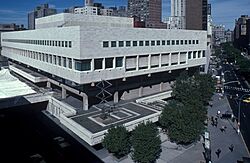
After William Schuman, composer Peter Mennin became president. Mennin made more changes to the music programs. He also helped Juilliard's international fame grow. For example, Juilliard student Van Cliburn won a major international music competition in the 1950s.
In 1968, Mennin hired John Houseman to start the new Drama Division. The school's name was changed to The Juilliard School to show that it now taught music, dance, and drama. The drama department first trained actors. Later, in the 1990s, it added programs for playwrights (people who write plays) and directors.
Modern Times: 1990–Present
Joseph W. Polisi was Juilliard's president for a long time, from 1984 to 2017. He helped the school become more modern. He started programs to help students from different backgrounds and improved the music programs. In 1991, Polisi created the Music Advancement Program (MAP). This program helps students from underrepresented groups who might not have access to music education in New York. In 2001, the school also started a jazz performance program.
By the end of the 1990s, Juilliard was known as a very important performing arts school. Many of its graduates played in top American orchestras. The school's financial support also grew a lot. In 1999, The Juilliard School received the National Medal of Arts, a very special award.
In 2015, Juilliard announced a big expansion. It opened a new school in Tianjin, China, in 2020. This was Juilliard's first full school outside the United States.
In May 2017, Damian Woetzel became the new president. From March 2020 through spring 2021, Juilliard switched to online classes because of the COVID-19 pandemic. Live performances were also stopped during this time.
In June 2021, some students protested about rising tuition costs. In September 2021, the school's Evening Division was renamed Juilliard Extension. It now offers programs both in person and online. In December 2021, a large gift of $50 million was given to the Music Advancement Program to help more students from diverse backgrounds.
Juilliard's Campus
<mapframe text="Juilliard School Campus 1. Alice Tully Hall, 2. Irene Diamond Building, 3. Meredith Willson Residence Hall" width="300" height="200" zoom="16" longitude="-73.9833" latitude="40.77386" >
{ "type": "FeatureCollection", "features": [
{ "type": "Feature", "properties": { "title": "Alice Tully Hall", "marker-symbol": "-number", "marker-color": "302060", "marker-size": "medium" }, "geometry": { "type": "Point", "coordinates": [-73.98255267162323, 40.77338364167763] }
},
{ "type": "Feature", "properties": { "title": "Juillliard School, Irene Diamond Building", "marker-symbol": "-number", "marker-color": "302060", "marker-size": "medium" }, "geometry": { "type": "Point", "coordinates": [-73.98328267162323,40.7738036] } }, { "type": "Feature", "properties": { "title": "Meredith Willson Residence Hall", "marker-symbol": "-number", "marker-color": "302060", "marker-size": "medium" }, "geometry": { "type": "Point", "coordinates": [-73.98408267162323,40.7740036] } } ] } </mapframe>
The Juilliard School is located in one main building, the Irene Diamond Building. It's part of the Lincoln Center for the Performing Arts in New York City. This building has many large studios and places for performances. These include dance studios, drama theaters, and music rehearsal rooms. There are also smaller halls for recitals. The building also includes Alice Tully Hall, a famous concert venue.
Next to the main Juilliard building is the Samuel B. & David Rose Building. This building is home to the Meredith Willson Residence Hall, where students live. It also has rooms for teachers and visiting artists.
How Juilliard is Run
Juilliard is led by a group called the board of trustees. They choose the school's president and manage its business. The school also has a president and other leaders for each of its main areas: dance, music, drama, and the pre-college division.
Juilliard works with other schools like Columbia University. It is also approved by a group called the Middle States Commission on Higher Education.
Academics at Juilliard
Getting into Juilliard
Juilliard accepts students for its college programs and its pre-college division. The pre-college program is for younger students (ages 8-18) who want to improve their skills. All students who want to join the Music Advancement Program or Pre-College Division must audition in person.
To apply to Juilliard, students must send an application, school records, and recommendations. Some programs also require recordings of their work. Only a small number of applicants are then invited to a live audition. After auditions, some students are invited to meet with a school leader. Juilliard is known as one of the most selective schools in the world. For example, in 2012, only about 7% of undergraduate applicants were accepted.
Juilliard students can also take classes at Columbia University. This is a special program for a small number of students each year.
Programs of Study
Juilliard offers programs in dance, drama, and music. All college degree programs include liberal arts courses. These classes cover subjects like writing, history, and culture.
The Dance Division started in 1951. It offers a Bachelor of Fine Arts degree or a Diploma. Students learn ballet, modern, and contemporary dance. They also study dance techniques and performance. The program focuses on performing, creating dances, and working with others.
The Drama Division began in 1968. It offers degrees for actors, including a Bachelor of Fine Arts and a Master of Fine Arts. It also has special programs for playwrights.
The Music Division is the largest part of the school. It offers many degrees, including Bachelor of Music and Master of Music. Students can major in instruments like piano, violin, guitar, or voice. They can also study composition (writing music) or conducting. The largest departments are strings and piano.
Juilliard also has special diploma programs for professional artists. These programs help performers advance their careers.
Pre-College Division
The Pre-College Division is for students in elementary, middle, and high school. Classes are held every Saturday from September to May at the Juilliard Building.
All pre-college students study music theory and how to read music (solfège). They also learn their main instrument. Singers learn about diction and performance. Pianists focus on piano performance. Students who play string, brass, or woodwind instruments, or percussion, also play in an orchestra. The pre-college has two orchestras. Students can also choose to study conducting, chorus, and chamber music.
The Pre-College Division started in 1916. It has helped many young musicians get top-level training.
Center for Innovation in the Arts
The Center for Innovation in the Arts (CIA) was created in 1993. It helps students use digital technology to create and perform new music. The center offers classes in music technology, music production, and film scoring.
In 2009, the center moved to a new, modern facility. It has a special room for mixing and recording music. It also has a digital "playroom" for composing and practicing with technology. The CIA is where many interdisciplinary projects and performances happen at Juilliard.
Musical Instruments at Juilliard
Juilliard has about 275 pianos, and most of them are Steinway grand pianos. It has one of the largest collections of Steinway pianos in the world.
The school also has several pipe organs in its practice rooms and performance halls.
The strings department allows students to borrow valuable old stringed instruments for special concerts. There are over 200 such instruments, including some made by famous makers like Antonio Stradivari.
Library and Collections
The Lila Acheson Wallace Library is Juilliard's main library. It has music scores, recordings, books, and videos. The school's archives also have special collections, including original music manuscripts. The library has over 87,000 music scores and 25,000 sound recordings.
In 2006, Juilliard received a collection of very valuable music manuscripts. These include original handwritten scores and notes from famous composers like Mozart, Bach, Beethoven, and Brahms. Many of these manuscripts had not been seen by the public for a long time. The entire collection has been put online so people can view it.
School Rankings
Juilliard is consistently ranked as one of the best performing arts schools in the world. From 2016 to 2021, it was ranked number one for performing arts by QS World University Rankings. In 2022, it was ranked third globally. For its 2022 ranking, Juilliard scored very high for its academic reputation. The Hollywood Reporter also ranked Juilliard as the top drama school in the world in 2021. In 2022, it was ranked fourth among music schools by the same publication.
Student Life at Juilliard
Students and Diversity
| Race and ethnicity | Total | ||
|---|---|---|---|
| White | 34% |
|
|
| International | 31% |
|
|
| Asian | 11% |
|
|
| Hispanic | 9% |
|
|
| Black | 8% |
|
|
| Other | 7% |
|
|
| Economic diversity | |||
| Low-income | 16% |
|
|
| Affluent | 84% |
|
|
As of the 2019–2020 school year, Juilliard had about 492 full-time undergraduate students and 374 graduate students. About 47% of all students were women. The school has worked to have a more diverse student body and programs. In 2018, it started an initiative to promote fairness, diversity, inclusion, and belonging. This includes workshops for teachers and staff. Student groups also hold activities to teach about diversity and different cultures.
Student Groups
Students at Juilliard have many clubs and organizations. The Juilliard Black Student Union (JBSU) started in 2016. The Alliance for Latin American & Spanish Students (ALAS) began in 2018. There are also groups like the Juilliard Chinese Student & Scholars Association and the Juilliard Green Club. Juilliard does not have any fraternities and sororities.
In the 1980s, Juilliard students had an ice hockey team called the Fighting Penguins. This was the first time the penguin was used as the school's mascot. Today, there is a faculty-staff softball team and a student volleyball club. Juilliard does not have official sports teams that compete against other schools.
Performing Groups
The Juilliard School has many different performing groups. These include groups for chamber music, jazz, orchestras, and vocal choirs. Juilliard's orchestras include the Juilliard Orchestra and the Juilliard Chamber Orchestra. The Axiom Ensemble is a student-run group that performs music from the 20th century.
The Juilliard Electric Ensemble started in 2003. It allows students to use technology to create and perform new music. This group performs works that use new technology by many modern composers.
Juilliard also has groups made up of its teachers, who perform often at the school. These include the Juilliard String Quartet and the American Brass Quintet.
Notable People from Juilliard
Alumni
Many people who studied at Juilliard have become very famous in the arts. They have won hundreds of awards, including Grammys, Oscars, Emmys, and Tonys. Juilliard alumni are often lead musicians in major symphony orchestras around the world. Many have also become solo performers. Alumni have won over 16 Pulitzer Prizes and 12 National Medals of Arts. Some alumni have even represented the United States as cultural ambassadors.
- Notable Juilliard alumni include:
-
Henry Mancini, film composer (entered 1942)
-
Miles Davis, jazz musician (entered Juilliard 1944)
-
Van Cliburn, classical pianist (Diploma, 1954)
-
Nina Simone, singer and pianist (entered Juilliard 1950)
-
Leontyne Price, opera singer (Special Studies 1952)
-
John Williams, film composer (entered Juilliard 1955)
-
Chick Corea, jazz composer (entered Juilliard 1960)
-
Philip Glass, composer (BM, 1960)
-
Pinchas Zukerman, violinist (Professional Studies, 1969)
-
Yo-Yo Ma, cellist (Pre-College, 1971)
-
Kevin Kline, actor (GrDiP, 1972)
-
Patti LuPone, actress (GrDiP, 1972)
-
Christine Baranski, actress (BFA, 1974)
-
Kelsey Grammer, actor (1973–1975)
-
Robin Williams, comedian and actor (1973–1975)
-
Christopher Reeve, actor (1973–1975)
-
William Hurt, actor (GrDip, 1976)
-
Mandy Patinkin, actor and singer (GrDiP, 1976)
-
Nigel Kennedy, violinist (c. 1972–1977)
-
Keith David, actor (BFA, 1979)
-
Kevin Spacey, actor (BFA, 1981)
-
Val Kilmer actor (BFA, 1981)
-
Midori Goto, classical violinist (entered Juilliard 1982)
-
Marcia Cross, actress (BFA, 1984)
-
Renée Fleming, soprano (AD in Opera Studies, 1987)
-
Laura Linney, actress (MFA, 1990)
-
Viola Davis, actress and producer (GrDiP, 1993)
-
Audra McDonald, actress and singer (BM, 1993)
-
Sarah Chang, classical violinist (BM, 1999)
-
Glenn Howerton, actor and writer (BFA 2000)
-
Anthony Mackie, actor (BFA, 2001)
-
Jessica Chastain, actress and producer (BFA, 2003)
-
Gillian Jacobs, actress and director (BFA, 2004)
-
Oscar Isaac, actor (BFA, 2005)
-
Adam Driver, actor (BFA, 2009)
Faculty
Juilliard has over 350 teachers. Many past and present teachers have won major awards. The school often holds special "master classes" where famous artists teach and share their knowledge. Some past guest artists have included Leonard Bernstein, Maria Callas, Luciano Pavarotti, and Itzhak Perlman.
- Notable present and past Juilliard faculty include:
See also
 In Spanish: Escuela Juilliard para niños
In Spanish: Escuela Juilliard para niños


